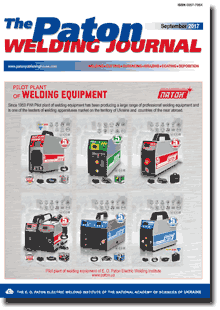| 2017 №09 (07) |
DOI of Article 10.15407/tpwj2017.09.08 |
2017 №09 (09) |

The Paton Welding Journal, 2017, #9, 44-49 pages
Classification and characteristic of defects of deposited layers according to the international standard ISO 6520-1:2007
I.A. Ryabtsev1, R. Rozert2, E. Turyk3 and I.I. Ryabtsev1
1E.O. Paton Electric Welding Institute, NASU 11 Kazimir Malevich Str., 03150, Kiev, Ukraine. E-mail: office@paton.kiev.ua
2Rosert RCT GmbH, Dresden, Germany
3Welding Institute, ul. B. Czeslawa 16–18, 44–100, Gliwice, Poland
Abstract
The review of defects of deposited layers on the basis of their classification system according to the International standard ISO 6520-1:2007 and its analogue GOST R ISO 6520-1:2012 was carried out. According to these standards, the welding (surfacing) defects are divided into six main groups with the corresponding three-digit number: cracks (100–106), cavities (200–203), solid inclusions (300–304), lacks of fusion and lacks of penetration (400–403), deviation from shape and sizes (500–521) and other defects (600–618), i.e. the defects, which are not included into the first five groups. Within each group, the defects are divided into the corresponding subgroups with four-digit numbers. The nature of defects of deposited layers was analyzed from the point of view of their admissibility and inadmissibility in the process of operation of deposited parts. 9 Ref., 17 Figures.
Keywords: surfacing, deposited metal, defects of deposited layers, classification of defects, admissible defects, inadmissible defects, quality evaluation
Received: 20.07.17
Published: 10.10.17
References
- Ryabtsev, I.A., Senchenkov, I.K., Turyk, E.V. (2015) Materials, technologies, mathematical modeling. Gliwice, Poland: SPI.
- ISO 6520-1:2007: Welding and allied processes: Classification of geometric imperfections in metallic materials. Pt 1: Fusion welding.
- GOST R ISO 6520-1–2012: Welding and related processes: Classification of defects of geometry and continuity in metallic materials. Pt 1: Fusion welding.
- DVS-Merkblatt DVS 0945-2: Unregelmaessigkeiten geschweisster Beschichtungen. DVS Media GmbH.
- DSTU EN 14700:2008: Welding consumables. Welding consumables for hard-facing.
- Protsenko, N.A., Ryabtsev, I.I. (2007) Harmonization of standards on surfacing consumables in accordance with European Standard EN 14700: Welding consumables for hard-facing. Svarshchik, 5, 30–38.
- Goral, T. (2007) Wplyw technologicznych parametrow napawania brazu na podloze stalowe na wybrane wlasciwosci uzytkowe napoin: Syn. of Thesis for Dr. of Sci. Degree, Krakow. http:// winntbg.bg.agh.edu.pl/rozprawy/9900/full9900.pdf
- Riabtsev, I.A.,Rosert, R., Senchenkow, I.K., Turyk, E. (2017) Niezgodnosci spawalnicze warstw napawanych. Instytutu Spawalnictwa, 3, 26–36.
- Chukhry, Ya. (1988) Fatigue resistance of specimens from 34KhNM steel, deposited by different methods. Svarka, 9, 66–67.
